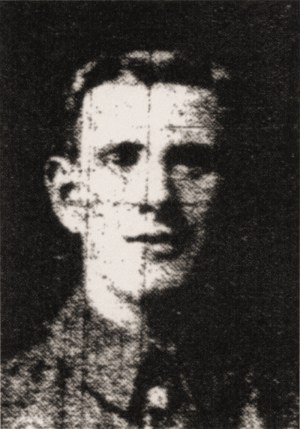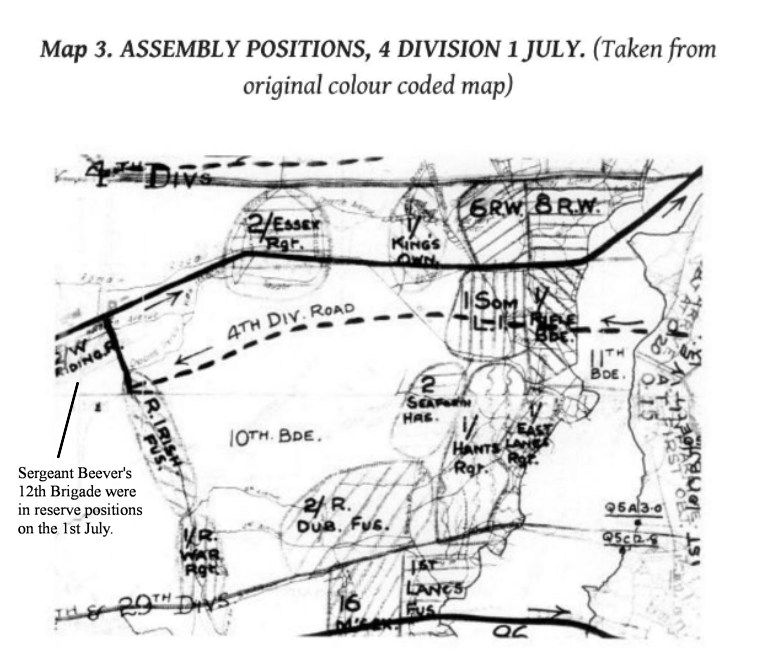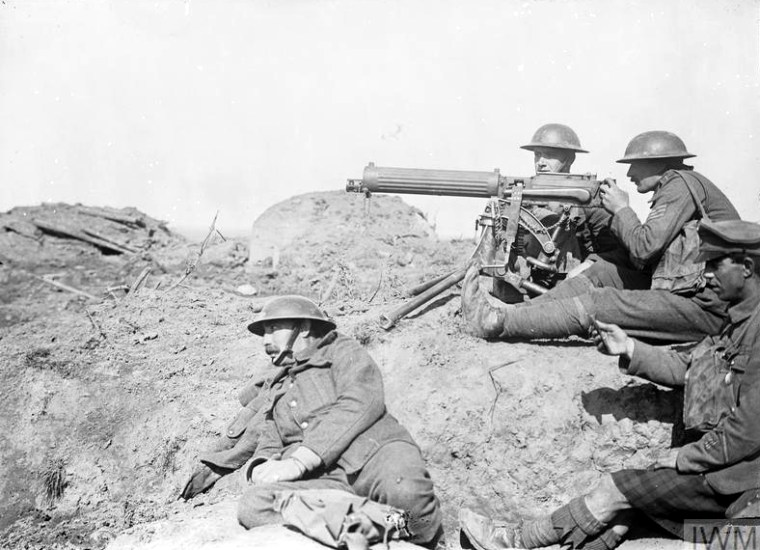 Sergeant George H. Beever, 16748, 12th Company Machine Gun Corps (Infantry)
Sergeant George H. Beever, 16748, 12th Company Machine Gun Corps (Infantry)
George Henry Beever was born at the Bull's Head Inn on Bank Street in Ossett on the 2nd February 1891, the second son of Huddersfield born Benjamin Beever, inn keeper and his wife Mary Alice, nee Hinchliffe, the daughter of Ossett farmer Thomas Hinchcliffe. The couple were married at Holy Trinity Church, Ossett on the 21st September 1887 and had four children: Tom born in Ossett in 1889 who died in 1930. Tom also served in WW1 as a gunner in the Royal Artillery; Emma born in 1892 in Ossett and William born in 1895 in Chickenley.
The family were living with Benjamin's widowed mother, Emma, the publican of the Bull's Head Public House on Bank Street, Ossett. George Henry was named after his grandfather, who had been the publican of The Bull's Head from 1873 to 1878 and then again from 1888. He died in Spring 1890 and the licence was then taken on by his wife Emma from the 5th May 1890 until December 1894 when the Bull's Head was taken on by George Scott1.
Benjamin Beever died at the early age of 32 years in Leeds in 1898 and Mary Alice moved with her four children to live at Shepley, Huddersfield, the place of her birth. In 1901, she was living close to the Sovereign Inn, Shepley with her three boys and was working as a laundress. She later remarried Wright Dearnley in Huddersfield in 1913.
George Henry Beever, now working as a quarry man, at Messrs Hampson's quarries, married spinster Ethel Hanwell Lower Hagg, Holmfirth at Holy Trinity Parish Church, Holmfirth on the 4th January 1913 when they were both 22 years of age. There were two children: Irene Beever, born on the 4th May 1913 and Douglas Beever, born on the 4th February 1915, both in Huddersfield. Ethel Beever died aged 44 years in 1936 and was buried on the 21st January 1936 at All Saints Churchyard in Netherthong, Huddersfield.
George Henry Beever, who played football with the Shepley, Hepworth and Cumberworth teams enlisted at Huddersfield in 1914 and joined the 2nd Battalion, Duke of Wellington's (West Riding) Regiment. Following several months of training he embarked for France arriving on 15th September 1915 as one of many replacements for what remained of his 2nd Duke of Wellington's Regiment. By 24th January 1916 he was part of the newly established 12th Machine Gun Company in the 12th Brigade of the 4th Division.
On the 1st July 1916, the capture of Redan Ridge, which lies between Serre and Beaumont Hamel was allotted to the 4th Division, including Beever's 12th Machine Gun Company Brigade. The 4th was a regular division of the British Army with experienced soldiers. When assaulted at 7.30am on the 1st July the attack failed in the face of dogged German defence.
Despite a huge 40,000 pound mine being exploded nearby at Hawthorn Ridge Redoubt in the adjoining sector after the British tunnelers dug deep under the German positions, the men of the 12th Brigade up on the Redan Ridge in the Auchonvillers sector heard nothing because of the intense noise of the barrage being laid down on the German defenders. Only those who actually saw the explosion had any idea what had occurred. As many of the men were either crouching in their trenches or lying down close to the ground in No Man's Land, it went largely unnoticed by men of the 4th Division, as did some of the smaller mines blown in their sector.
The ground across which they had to attack was completely open, without a scrap of cover, and from the right sloped up to the left until it reached the top of the ridge, where the Germans had constructed a large defensive position, which dominated the area from all directions. The British marked this as Ridge Redoubt on their maps. The ground then sloped more gently to the left and there was some 'dead' ground that is ground that could not be covered by fire from Ridge Redoubt, near the Divisional boundary with 31st Division.
However, this area was confronted by another stronghold, a salient known as the "Quadrilateral" to the British troops and "Heidenkopf" to the Germans, apparently named after one of their senior officers.
The story of the attack in broad terms can be recorded quite briefly. It failed because of intense machine gun fire which was already pouring on to the attacking troops before 'Zero Hour'. On the right of the attack (to the south) below the redoubt, no-one got into the enemy front line, except one small party of the 1st East Lancs Regiment who got into a communications trench leading to the German second line, but they were never heard of again.
On the left (to the north) of the attack, where the ground was slightly more favourable, the German front line and the Quadrilateral were occupied by the British. The communications trenches between the front and second lines were filled with men of various regiments and some of the second line was also taken. Further north, right on the divisional boundary, some men of the 8th and 6th Royal Warwicks, 1st Essex, 2nd Lancs Fusiliers and 1st Kings Own broke through and reinforced by some men of the Northern 'Pals' battalion, possibly the 'Leeds Pals' battalion, as they were the closest, advanced to Pendant Copse, a small wood behind the village of Serre and well beyond the German second main position known as Munich Trench. They were never seen again.2

The German dugouts were in some cases 30ft deep and the Germans were untouched by the British artillery fire.
This account gives an idea of the casualties suffered by Beever's 12th Brigade:
"The 10th and 12th Brigades reinforced us (1st Somerset Regiment), but they were met with withering fire and practically annihilated. Their wounded were everywhere, and the dead heaped on top of each other, where the machine guns had caught them."
Sergeant George Henry Beever was one of 12 men of the 12th Brigade, Machine Gun Company that died on the 1st July 1916 in the failed attempt to take Redan Ridge.

Above: A company of Machine Gun Corps (Infantry) courtesy of the Imperial War Museum.
The widow of Sergeant George Henry Beever was eventually sent medals her husband had been awarded after his death in 1916. these were the British and Victory Medals and the 1914-15 Star for serving overseas on or before 31st December 1915.
George Henry Beever is remembered at the Thiepval Memorial to the Missing of The Somme and the Shepley Methodist Church War Memorial.
The Thiepval Memorial, the Memorial to the Missing of the Somme, bears the names of more than 72,000 officers and men of the United Kingdom and South African forces who died in the Somme sector before 20 March 1918 and have no known grave. Over 90% of those commemorated died between July and November 1916. The memorial also serves as an Anglo-French Battle Memorial in recognition of the joint nature of the 1916 offensive and a small cemetery containing equal numbers of Commonwealth and French graves lies at the foot of the memorial.3
References:
1. "Ossett Pubs" by Brian Smith
2. "Redan Ridge: Somme" by Michael Renshaw. Casemate Publishers, 19th Nov 2004.